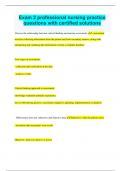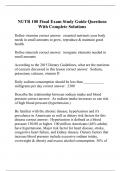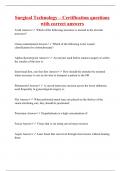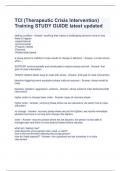6. RCTs in Action: Human Capital Policies in Developing Countries
(D. Emmers)
1. Introduction
Millenium Development Goal in 2000
This is an important call to action!
= “Ensure that, by 2015, children everywhere, boys and girls alike, will be able to complete a full course of
primary schooling”
Human capital policies have been at forefront in the “battle against poverty” for more than a decade.
Large response of governments worldwide. Between 1999-2006 enrollment rates in primary school increased
from 54% to 70% in sub-Saharan Africa and from 75% to 88% in East and South Asia.
Goal of universal primary school enrollment does not seem far off... Or does it?
The Catch
Millennium Development Goal does not specify that children should learn anything, just that they should be
enrolled in primary education. That is exactly what happened.
While enrollment increased dramatically, average test scores did not.
Study by Pratham (2005) - a very large Indian NGO with focus on improving educational outcomes - found that
among 700 000 randomly chosen children across India, 35% could not read a basic paragraph at end of primary
school and 60% could not read a simple story. Only 30% were found to have some basic math competencies.
Why Schools Fail
How come increased enrollment rates have not led to increased human capital? Can RCTs teach us something
about why many human capital policies in developing countries have failed?:
1. Ghost Teachers (Chaudhury et al., 2006)
Unannounced visits to primary schools find an average of 19 percent of teachers absenteeism across random
selection of schools in Bangladesh, Ecuador, India, Indonesia, Peru and Uganda. This is a lower bound estimate
given that many teachers were present but not working during the unannounced visits
Unannounced visits to primary schools find an average of 19 percent of teachers absenteeism across random
selection of schools in Bangladesh, Ecuador, India, Indonesia, Peru and Uganda. This is a lower bound estimate
given that many teachers were present but not working during the unannounced visit.
- More absence among male and higher educated teachers
- More absence in low-infrastructure schools
- More absence in schools with higher parental illiteracy rates
,This points to the problem of monitoring!
- Absence rates in primary schools and health centers.
- India: absence rate is even higher than the average of 19%. 1 out of 4 in primary schools were not
present during the unannounced visits.
- So teachers don’t show up even though students are enrolled in primary school!!! This is a huge
problem!
2. Elitist Teaching: making more efforts to teach to the elite students.
Expectations and Stereotypes:
- Two-Tier Systems (Duflo, Dupas and Kremer, 2011)
Teachers randomly assigned to bottom and top class based on previous achievement were found to be
significantly less likely to teach during unannounced visits when assigned to the bottom class. So
teachers are more likely to teach to higher ability students than to lower ability children. So the lower
ability children are not able to catch up in terms of skills development.
- What Is In A Name (Hanna and Linden, 2009)
Teachers randomly assigned to grading exams with students name visible and without students name
were found to give significantly lower grades to lower-cast students. Moreover, lower-cast teachers
were more likely to give lower grades to lower-cast students than higher-cast teachers.
Text Book RCT (Glewwe, Kremer and Moulin, 2000)
In the early 1990s Micheal Kremer looked for simple test case to design one of first RCTs of a policy
intervention in a developing country. He wanted a noncontroversial example with large expected effects.
His basic idea was to randomly introduce text books in Western Kenya. Given the scarcity of books in Kenyan
schools and the near-universal consensus that books are essential inputs, this seemed like the perfect example
to show the strength of simple interventions.
, The results were very disappointing, no significant difference in test scores between control and treatment
schools was found.
Only the students at the upper-end of ability distribution did benefit from the text book intervention. Why?
Simple answer: The textbooks were in English, which is Kenya’s language of education. For most children, but
the elite, English is only the third language.
But why did they only provide English textbooks…? That is because of the Colonial Hang-Over Problem of
Schooling Institutions: “The curriculum and organization of schools often dates back to a colonial past, when
schools were meant to train a local elite to be effective allies of the colonial state. The goal was to maximize
the distance between them and the rest of the populace.” (Poor Economics by Banerjee and Duflo, 2011)
School systems often still set-up to prepare the best-performing students for a public exam that opens doors
to roles in public office.
Most children, therefore, get left-behind without much learning.
Don’t Throw out Baby with the Bathwater
Scepticism about Input-Efficiency:
Disappointing results of first-generation RCT interventions focusing on large-scale supply-side human capital
interventions generated a large debate within the development economics community. Instead of focusing on
the supply-side some economist felt that demand-side interventions would be more fruitful.
Refer to Chapter 4 of “Poor Economics” for more on this subject.
Second-Generation RCT’s: it gave more Attention to Mechanisms:
- Ghost Teachers: New evidence shows that teachers do respond to incentives. Getting teachers to
teach might depend on the right type of monitoring and financial incentives.
- Elitist Teaching: Inputs specifically targeted to teach along the full distribution of ability are effective in
raising human capital outcomes.
Now we are going to look at Cost-Effective Human Capital Interventions (point 2, 3 & 4):
(D. Emmers)
1. Introduction
Millenium Development Goal in 2000
This is an important call to action!
= “Ensure that, by 2015, children everywhere, boys and girls alike, will be able to complete a full course of
primary schooling”
Human capital policies have been at forefront in the “battle against poverty” for more than a decade.
Large response of governments worldwide. Between 1999-2006 enrollment rates in primary school increased
from 54% to 70% in sub-Saharan Africa and from 75% to 88% in East and South Asia.
Goal of universal primary school enrollment does not seem far off... Or does it?
The Catch
Millennium Development Goal does not specify that children should learn anything, just that they should be
enrolled in primary education. That is exactly what happened.
While enrollment increased dramatically, average test scores did not.
Study by Pratham (2005) - a very large Indian NGO with focus on improving educational outcomes - found that
among 700 000 randomly chosen children across India, 35% could not read a basic paragraph at end of primary
school and 60% could not read a simple story. Only 30% were found to have some basic math competencies.
Why Schools Fail
How come increased enrollment rates have not led to increased human capital? Can RCTs teach us something
about why many human capital policies in developing countries have failed?:
1. Ghost Teachers (Chaudhury et al., 2006)
Unannounced visits to primary schools find an average of 19 percent of teachers absenteeism across random
selection of schools in Bangladesh, Ecuador, India, Indonesia, Peru and Uganda. This is a lower bound estimate
given that many teachers were present but not working during the unannounced visits
Unannounced visits to primary schools find an average of 19 percent of teachers absenteeism across random
selection of schools in Bangladesh, Ecuador, India, Indonesia, Peru and Uganda. This is a lower bound estimate
given that many teachers were present but not working during the unannounced visit.
- More absence among male and higher educated teachers
- More absence in low-infrastructure schools
- More absence in schools with higher parental illiteracy rates
,This points to the problem of monitoring!
- Absence rates in primary schools and health centers.
- India: absence rate is even higher than the average of 19%. 1 out of 4 in primary schools were not
present during the unannounced visits.
- So teachers don’t show up even though students are enrolled in primary school!!! This is a huge
problem!
2. Elitist Teaching: making more efforts to teach to the elite students.
Expectations and Stereotypes:
- Two-Tier Systems (Duflo, Dupas and Kremer, 2011)
Teachers randomly assigned to bottom and top class based on previous achievement were found to be
significantly less likely to teach during unannounced visits when assigned to the bottom class. So
teachers are more likely to teach to higher ability students than to lower ability children. So the lower
ability children are not able to catch up in terms of skills development.
- What Is In A Name (Hanna and Linden, 2009)
Teachers randomly assigned to grading exams with students name visible and without students name
were found to give significantly lower grades to lower-cast students. Moreover, lower-cast teachers
were more likely to give lower grades to lower-cast students than higher-cast teachers.
Text Book RCT (Glewwe, Kremer and Moulin, 2000)
In the early 1990s Micheal Kremer looked for simple test case to design one of first RCTs of a policy
intervention in a developing country. He wanted a noncontroversial example with large expected effects.
His basic idea was to randomly introduce text books in Western Kenya. Given the scarcity of books in Kenyan
schools and the near-universal consensus that books are essential inputs, this seemed like the perfect example
to show the strength of simple interventions.
, The results were very disappointing, no significant difference in test scores between control and treatment
schools was found.
Only the students at the upper-end of ability distribution did benefit from the text book intervention. Why?
Simple answer: The textbooks were in English, which is Kenya’s language of education. For most children, but
the elite, English is only the third language.
But why did they only provide English textbooks…? That is because of the Colonial Hang-Over Problem of
Schooling Institutions: “The curriculum and organization of schools often dates back to a colonial past, when
schools were meant to train a local elite to be effective allies of the colonial state. The goal was to maximize
the distance between them and the rest of the populace.” (Poor Economics by Banerjee and Duflo, 2011)
School systems often still set-up to prepare the best-performing students for a public exam that opens doors
to roles in public office.
Most children, therefore, get left-behind without much learning.
Don’t Throw out Baby with the Bathwater
Scepticism about Input-Efficiency:
Disappointing results of first-generation RCT interventions focusing on large-scale supply-side human capital
interventions generated a large debate within the development economics community. Instead of focusing on
the supply-side some economist felt that demand-side interventions would be more fruitful.
Refer to Chapter 4 of “Poor Economics” for more on this subject.
Second-Generation RCT’s: it gave more Attention to Mechanisms:
- Ghost Teachers: New evidence shows that teachers do respond to incentives. Getting teachers to
teach might depend on the right type of monitoring and financial incentives.
- Elitist Teaching: Inputs specifically targeted to teach along the full distribution of ability are effective in
raising human capital outcomes.
Now we are going to look at Cost-Effective Human Capital Interventions (point 2, 3 & 4):










